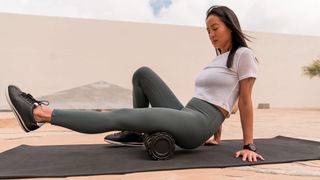The Wave Roller offers five different vibrating speeds and works with the revamped Therabody app (iOS, Android) to personalize your foam roller warm-up and recovery routines, based on the type and frequency of workouts you’re doing. That’s clever, as it cuts out a lot of the guess work for you, and it’s the same approach taken by the Theragun Mini (opens in new tab), our top pick of the best handheld massagers. So this smart home gym (opens in new tab) device is designed to help you warm-up more effectively, recover faster post-exercise, and to release any muscle tension you might be feeling. The Wave Roller measures 12-inches long and is made from a high-density PU foam, which also has an insulating effect, reducing the noise of those good vibrations. The Wave Roller can be used on your:
LegsArmsBackGlutes, and more
The Wave Roller is available to buy now at Therabody (opens in new tab) for $149/£125, and is enabled for wireless charging, making it easy to keep powered in between uses. Battery life is quoted as three hours, and you can buy a wireless charging pad at Therabody for $79/£75. Therabody’s vibrating smart foam roller was announced in May, at the same time the company rebranded and introduced the new Theragun Mini, a powerful yet portable percussive massager that delivers relaxing and therapeutic massage wherever you need it. The roller gets its name from the wave-shaped grooves running along its length, providing added texture and traction when applying pressure across the areas of your body where you need sweet relief.
Shop the Wave Roller at Therabody (opens in new tab)Shop the Wave Roller at Target (opens in new tab)
How does the Wave Roller release muscle tension?
According to Therabody, the Wave Roller has been created to accelerate your warm-up routine, boost recovery, increase blood flow, enhance mobility, and release muscle tension. The smart roller utilizes vibration therapy, which works in tandem with that unique wave pattern to constantly manipulate the tissue that surrounds and covers your muscles and bones. In theory, this should make for a deeper, more effective muscle stimulation. We say in theory because we haven’t reviewed the Wave Roller yet (stay tuned). Traditional foam rollers use pressure from your body weight to help relax your muscles, whereas the Wave Roller uses vibration and other smarts as the energy source to relax your muscles. Download the app to your smartphone (opens in new tab) and you can dig into the various wellness routines created by Therabody’s education division, Theragun University, based on your health activity data (collated by the app). The app offers up routines based on different ailments, body parts, and activities. It’ll show the specific muscle, ideal length of time for treatment, the most effective speed, and the amount of pressure that should be applied.
Do foam rollers actually work?
Compared to more popular areas of health and fitness tech, such as a treadmill (opens in new tab) or exercise bike (opens in new tab), research into the effectiveness of foam rolling (self-myofascial release therapy) is smaller but promising. There’s also plenty of healthy debate over whether foam rolling is a more effective way to warm-up compared to standard stretching. The Mayo Clinic (opens in new tab) has produced a guide to the basics, with suggested moves and routines if you’re using a standard foam roller. There’s a decent amount of research to support the claim that foam-rollers create short-term increases in flexibility and, if done regularly, may improve it for the long-term. As for recovery, recent research (opens in new tab) has shown that foam-rolling can decrease the sensation of Delayed Onset Muscle Soreness (DOMS). It’s worth noting, however, that the sample group was small, so larger studies would be welcome here.






